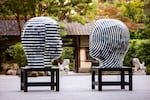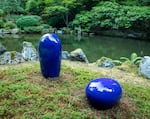
Jun Kaneko attends a reception ahead of the opening of "Garden of Resonance."
Courtesy Portland Japanese Garden, Photo by Nina Johnson
When Japanese American artist Jun Kaneko was first approached by Portland Japanese Garden staff to host an exhibition, he didn’t respond to them for weeks on end.
“I had it on my table for about two months,” Kaneko says.
It wasn’t the logistics that worried the artist — his hands hold decades of experience in creating larger-than-life ceramic statues for exhibitions across the globe — but rather how his work might take away from the garden.
“The garden is already complete. It’s a beautiful garden… So if I put my piece, there is a big chance of disturbing the existing beautiful garden. I said, ‘You people should consider not to put any piece for the show in the garden, because I’m really afraid.’”
However, the garden management was persistent. They ultimately put Kaneko’s worries to rest by designing the exhibition in a way that almost feels like a scavenger hunt without disturbing the intricate ecosystem of the garden.
Today, Kaneko’s structures carefully mingle with the green and auburn expanse of the garden.
The installment is part of the ongoing exhibition “Garden of Resonance: The Art of Jun Kaneko,” which began on Oct. 1 and will run through Feb. 20. The exhibition stretches across 12 acres of greenery, with intriguing ceramic pieces tucked into various corners of the cultural oasis. Each sculpture demands your attention with striking geometric patterns.
Apart from Kaneko’s signature outdoor ceramic statues, the exhibition also features abstract paintings in the garden’s Pavilion Gallery.

More of Jun Kaneko's work at the exhibition, "Garden of Resonance."
Courtesy Portland Japanese Garden, Photo by Jonathan Ley
Frank Feltens, the Portland Japanese Garden’s guest curator who worked on this project, took this as an opportunity to really take a deep dive into Kaneko’s artwork and the philosophy that came with it. Feltens is also the Japan Foundation associate curator of Japanese art at the Smithsonian’s National Museum of Asian Art.
“In my personal opinion, so many of Kaneko’s works are really a product of his unrelenting willpower, his unrelenting effort to be creative and to constantly challenge himself and the medium he’s working in,” Feltens explains. Kaneko is an artist ruled by intuition.
“I don’t really plan too much,” he admits.
The Omaha, Nebraska-based artist, who was awarded the Lifetime Achievement Award from the International Sculpture Center in 2021, looks at his creation process as a conversation.

This photo shows one of Jun Kaneko's larger-than-life untitled artworks on display at the Portland Japanese Garden.
Courtesy Portland Japanese Garden, Photo by Jonathan Ley
“I look at the piece, I get a reaction from it, and then I try to see if I could improve on that, and then I will try to do that.” He hardly worries about his finished work.
“My issue is, can I maintain my energy, my curiosity about what I’m doing?” Kaneko ponders. “If that thing starts disappearing, then I would really worry about it.”
But Kaneko manages to keep viewers on their toes, giving no context to his work whatsoever.
The 80-year-old artist is notorious for leaving his work untitled to challenge the “freedom of thinking.”
This allows art enthusiasts an opportunity to interact with his work on their own rather than following a formalized interpretation. The change of seasons, the time of day, the location in itself — all of these little things factor into one’s interpretation and how one would perceive Kaneko’s work. This interaction is as organic as it can be.
“I think if I put a title on any piece, that will already limit other people’s freedom to look at it,” Kaneko says. “I feel like everyone is different in this world — everybody has a different background. Even when you’re looking at the same thing, we think of different kinds of stuff. So it’s a question of personality. How much do you want to be open?”
From oversize heads that take center space in the garden’s courtyard to tiny “dango” (Japanese word for dumpling) structures unassumingly tucked away into a corner, Kaneko’s work is diverse, yet consistent.
But does the artist have a favorite? “Well, you know, I always say my next piece will be my favorite.”

A ceramic statue by Jun Kaneko is nestled into a corner of the garden as part of the exhibition, "Garden of Resonance."
Courtesy Portland Japanese Garden, Photo by Jonathan Ley
